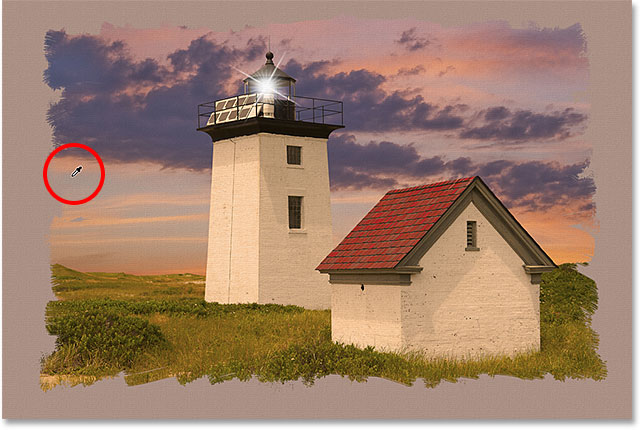
Painted Edges Photo Border With Photoshop CS6
Version note: This tutorial is for Photoshop CS6. An updated version is available for Photoshop CC 2020.
In this Photoshop tutorial, we'll learn how to easily add a photo border to an image that makes it look as if the photo was painted on canvas.
To create the effect, we'll be using a Solid Color fill layer along with a layer mask, loading in some brushes from one of Photoshop's additional brush sets, applying a texture from the Filter Gallery, and at the very end, we'll learn how to sample a color directly from the photo itself to use as the color of our canvas.
I'll be using Photoshop CS6 for this tutorial. If you happen to be using Photoshop CS5 or earlier, you can also check out the original version of the tutorial.
Here's the photo I'll be starting with (lighthouse photo from Shutterstock):

And here's what the final "painted edges photo border" will look like. In this example, the canvas color around the image is white, but as I mentioned, we'll learn at the end of the tutorial how to change it by sampling a new color directly from the photo itself:
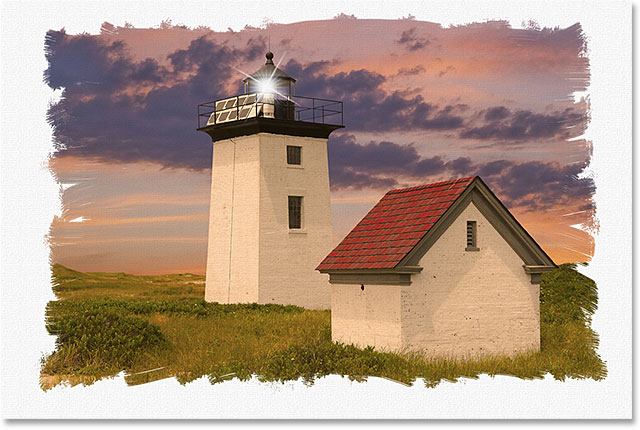
How To Create A Painted Edges Photo Border
Step 1: Add A White Solid Color Fill Layer
With our photo newly opened in Photoshop, let's start by adding a white-filled layer above our image. Click on the New Fill or Adjustment Layer icon at the bottom of the Layers panel:
This opens a list of all the fill and adjustment layers we can choose from. Select a Solid Color fill layer from the top of the list:
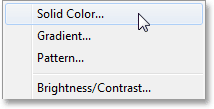
Photoshop will pop open the Color Picker so we can choose the color we want to fill the layer with. This layer is going to become the canvas behind the image so let's initially choose white by entering a value of 255 for the R, G and B options (which stand for Red, Green and Blue) near the bottom center of the dialog box:

Click OK to close out of the Color Picker. Your document will appear completely filled with white, temporarily blocking the photo from view, and if we look in the Layers panel, we see the Solid Color fill layer (named Color Fill 1) sitting above the Background layer which holds our image:
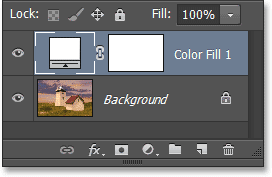
Step 2: Select The Fill Layer's Mask
Select the layer mask for the fill layer by clicking on its mask thumbnail in the Layers panel. A white highlight border will appear around the thumbnail letting you know the layer mask is now selected. In a moment, we're going to begin painting on the mask to allow the photo below the fill layer to show through:
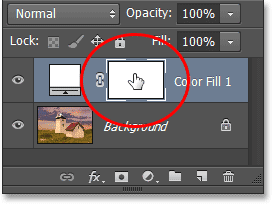
Step 3: Select The Brush Tool
Grab Photoshop's Brush Tool by clicking on its icon in the Tools panel along the left of the screen:

Step 4: Load The "Thick Heavy Brushes" Brush Set
With the Brush Tool selected, click on the Brush Presets icon near the far left of the Options Bar along the top of the screen:

This opens the Brush Preset Picker. The brushes we want to use for this effect are not loaded into Photoshop by default so we need to load them in manually. Click on the small menu icon (the little gear icon) in the top right corner of the Brush Preset Picker:
This opens a menu with various options, including a list of additional brush sets ready to load into Photoshop. Click on the Thick Heavy Brushes set near the bottom of the list to select it:
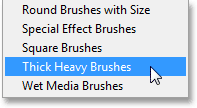
Photoshop will ask if you want to replace the original brushes with the new brush set. Click the Append button to simply add these new brushes in with the originals. They'll appear below the original brushes in the list:
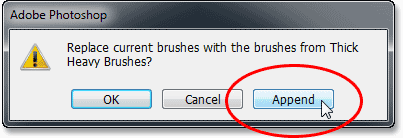
Step 5: Choose The "Flat Bristle" 111 px Brush
With the new brush set loaded in, click again on the menu icon in the top right corner of the Brush Preset Picker:
Then choose either Small List or Large List from the menu when it appears. This will display the brushes in the Brush Preset Picker as a list that will make it easier to choose the brushes we need. I'm going to choose Large List:
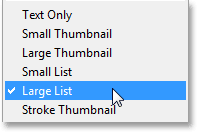
Scroll down the list of available brushes in the Brush Preset Picker until you find the Flat Bristle 111 px brush (it will be near the bottom of the list). Double-click on it to select it and close out of the Brush Preset Picker:
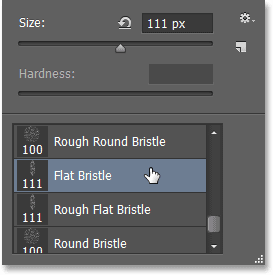
Step 6: Paint With Black On the Layer Mask
We need to paint with black on the layer mask to reveal the photo underneath the Solid Color fill layer. Photoshop uses the current Foreground color as the brush color, so press the letter D on your keyboard to quickly reset your Foreground and Background colors, which will make your Foreground color white and your Background color black. Then press the letter X on your keyboard to swap them so your Foreground color becomes black. You can see the current Foreground and Background colors in the color swatches near the bottom of the Tools panel:

Then, simply begin painting brush strokes across the main part of the image from left to right. Since we're painting on the layer mask, you won't actually see the black brush color. Instead, with each new brush stroke, more of the original image below the Solid Color fill layer will be revealed. If you're not happy with one of your brush strokes, press Ctrl+Z (Win) / Command+Z (Mac) on your keyboard to undo it, then continue painting:
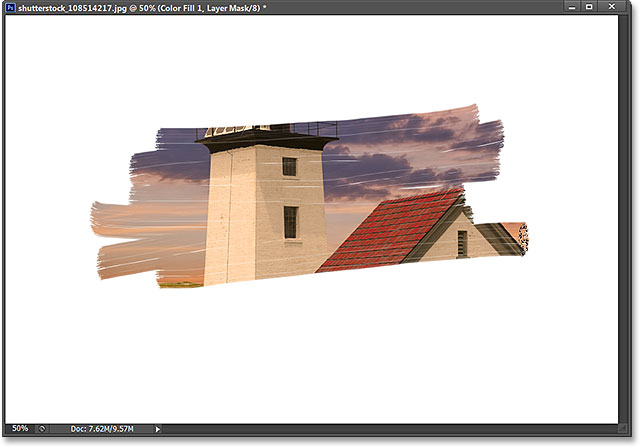
Continue painting brush strokes until you've revealed enough of your image, keeping lots of room around the edges for the canvas area:
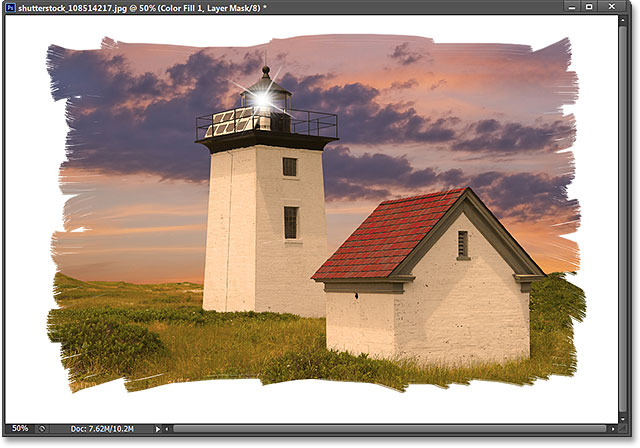
Step 7: Select The "Rough Flat Bristle" 111 px Brush
Let's enhance the painted edges effect with a different brush. Right-click (Win) / Control-click (Mac) anywhere inside the image to re-open the Brush Preset Picker. You'll find the Rough Flat Bristle 111 px brush directly below the Flat Bristle brush we initially selected. Double-click on it to select it and close out of the Brush Preset Picker:
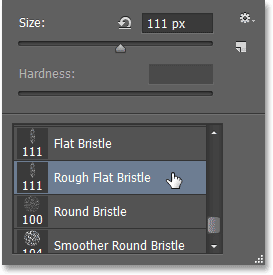
Step 8: Paint Smaller Strokes Around The Edges
With the new brush selected, go around the edges of the image and paint small strokes to add some paint specks and splatters to the effect. Try to keep most of the brush inside the already painted area so that only a small bit of it extends out beyond the edges. You don’t want to overdo it here. Allow only a tiny bit of the brush to extend into the white area and paint with very short strokes. Even simply clicking an area once or twice with the brush can be enough. Again, if you feel you've made a mistake, press Ctrl+Z (Win) / Command+Z (Mac) to undo and try again:
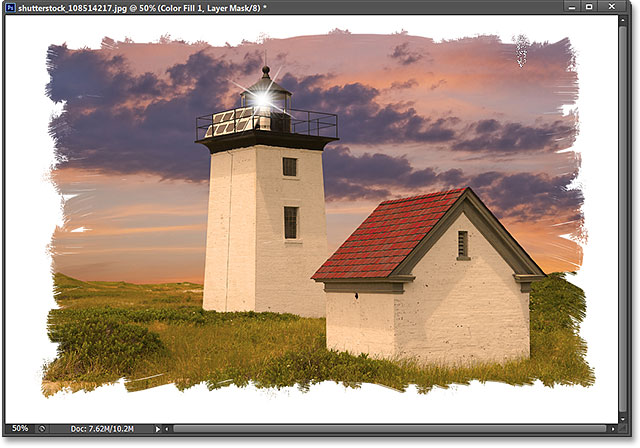
Step 9: Add A New Blank Layer
Let's finish off the main effect by adding a canvas texture. Click on the New Layer icon at the bottom of the Layers panel:
This adds a new blank layer named Layer 1 directly above the Solid Color fill layer:
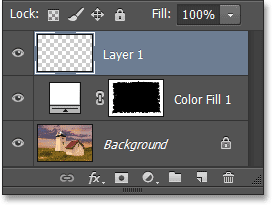
Step 10: Fill The New Layer With White
At the moment, the new layer is blank so let's fill it with white. Go up to the Edit menu in the Menu Bar along the top of the screen and choose Fill:
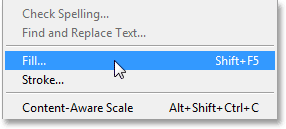
This opens the Fill dialog box. Set the Use option at the top of the dialog box to White. Make sure the Mode option near the bottom is set to Normal and Opacity is set to 100%, then click OK to accept it and exit out of the dialog box. Photoshop will fill the layer with white, once again temporarily blocking everything else from view in the document window:
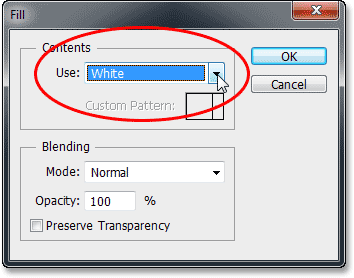
Step 11: Apply The Texturizer Filter
Go up to the Filter menu at the top of the screen and select the Filter Gallery:
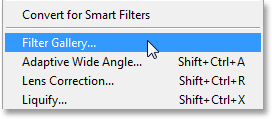
When the Filter Gallery appears, click on the Texture category in the middle column to twirl it open and view the various filters in that category, then select the Texturizer filter by clicking on its thumbnail:
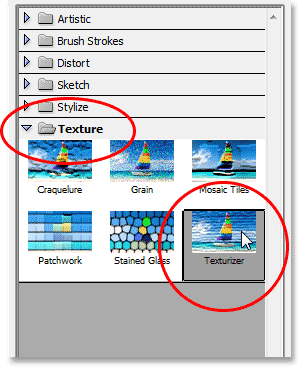
The controls and options for the Texturizer filter appear in the right column of the Filter Gallery. First, set the Texture option to Canvas. Leave Scaling set to 100% and set the Relief to 4. Select Top Left for the Light option:
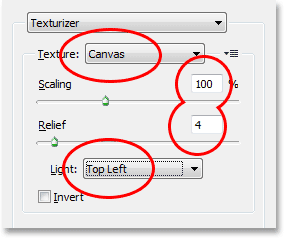
When you're done, click OK to close out of the Filter Gallery. Photoshop fills the layer with the canvas texture (I've enhanced it a little bit here just to make it easier to see in the screenshot):
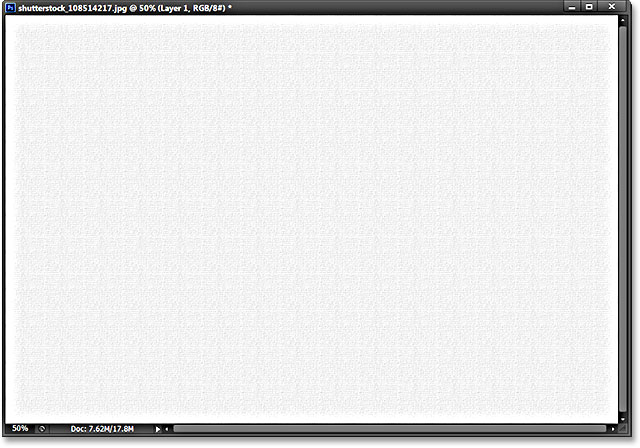
Step 12: Change The Layer's Blend Mode To Multiply And Lower The Opacity
To blend the canvas texture with the rest of the image, simply change the layer's blend mode from Normal to Multiply. You'll find the Blend Mode option in the top left corner of the Layers panel:
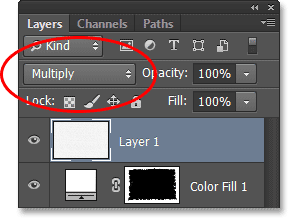
Then, to fade the texture so it appears more subtle, lower the layer's opacity value down to around 30%. The Opacity option is directly across from the Blend Mode option at the top of the Layers panel:
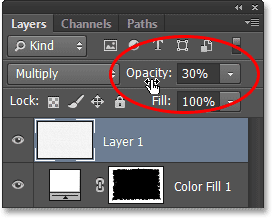
Here's my effect after changing the blend mode to Multiply and lowering the opacity. The canvas texture is pretty hard to see in the small screenshot here but should be easily visible in your document:
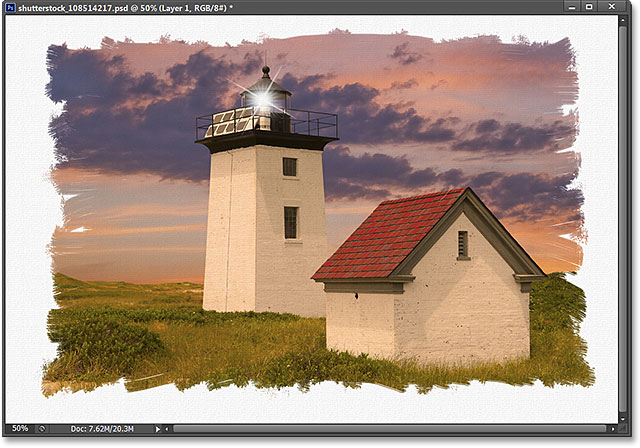
Changing The Canvas Color (Optional)
At this point, the effect is complete and if you're happy with using white for your canvas color, you can stop here. If you want to try a different color for the canvas, the easiest thing to do is sample a color directly from the photo itself. To do that, double-click on the Solid Color fill layer's thumbnail (the little color swatch icon to the left of the layer mask thumbnail):
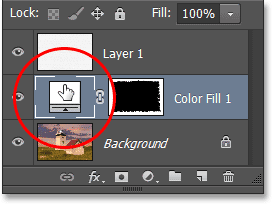
This will open the Color Picker. Rather than choosing a color from the Color Picker, move your mouse cursor over an area of your image that contains a color you want to sample. Your mouse cursor will change into an eyedropper icon. Simply click on the color to sample it and your canvas will instantly change to the new color. You can click on as many different colors as you like until you find the one that works best. Click OK when you're done to accept the new color and close out of the Color Picker. Or, if you can't find a color that works, click Cancel to close out of the Color Picker and leave your canvas set to white:
